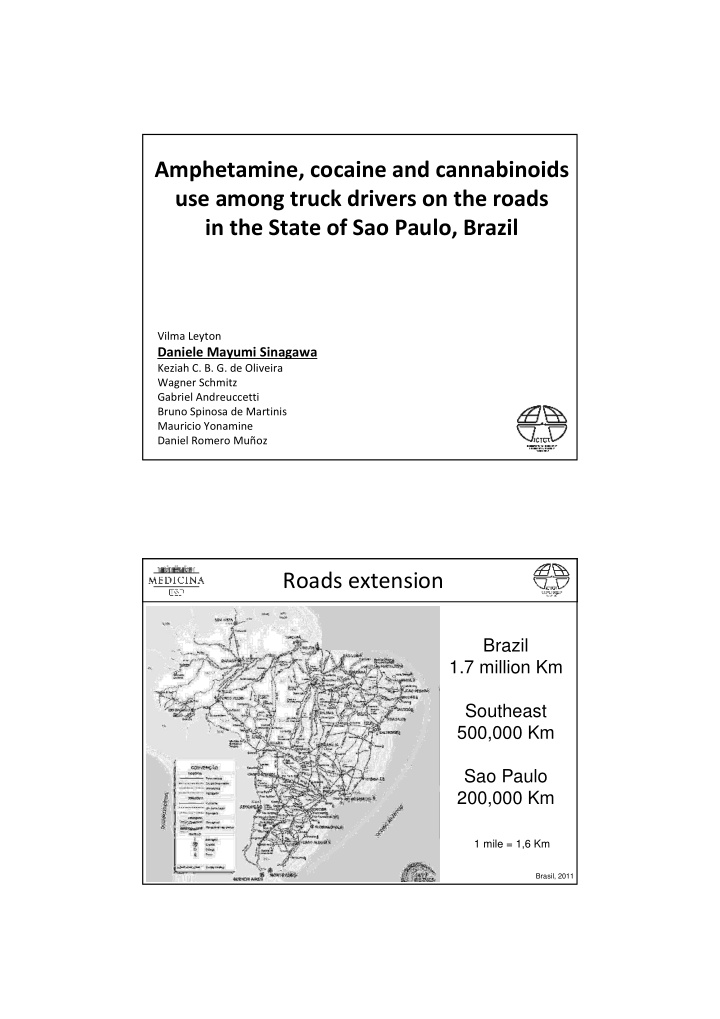



Amphetamine, cocaine and cannabinoids use among truck drivers on the roads in the State of Sao Paulo, Brazil Vilma Leyton Daniele Mayumi Sinagawa Keziah C. B. G. de Oliveira Wagner Schmitz Gabriel Andreuccetti Bruno Spinosa de Martinis Mauricio Yonamine Daniel Romero Muñoz Roads extension Brazil 1.7 million Km Southeast 500,000 Km Sao Paulo 200,000 Km 1 mile = 1,6 Km Brasil, 2011
Roads extension -2,143,467 TRUCKS in Brazil - The truck drivers in Brazil often report the drug use to keep the state of alertness and to be able to accomplish their extensively long journeys Drugs and driving - The more commonly used by truck drivers are: * Amphetamines * Cocaine * Cannabis
Drugs and driving DRIVING � involves multiple procedures that are coordinated by our Central Nervous System Increase the risk of traffic accidents Traffic accidents - per year DEATHS INJURIES 1.3 million 20-50 million ↑ 43,000 160,000
Project University of Sao Paulo Medical School Department of Federal Highway Police “Health Commands on the Roads” Aim The purpose of this study was to demonstrate the prevalence of drug use (amphetamines, cocaine, cannabinoids) by truck drivers on the roads of Sao Paulo State, during 2009.
Roseira y Fernão Dias Highway a w h g H i a r t Atibaia u D e t n e d i s e r P Guarulhos Régis Bittencourt Highway Itapecerica da Serra Drivers approach
Activities Samples colletion Truck drivers who participated of our study: * They were informed about the aim of the study; * Signed the consent term; * Answered to questionnaire informing about their health and work conditions and drug use; * Provided an urine sample.
Consent Term Questionnaire
Casuistic Drivers approach: - 488 drivers were approached - 456 provided urine samples Sample collection
Toxicological analysis a) SCREENING Multidrogas One Step Teste - INLAB Toxicological analysis Examples of positive samples
Toxicological analysis b) CONFIRMATION Gas chromatography - mass spectrometry (GC-MS) Results - All of the drivers were male; - The mean age was 40 ± 10.8 years; Positive samples: 42.86% between 25-34 years - Health: 29.3% reported having at least one health problem: diabetes, high blood pressure and/or stress.
Results When asked about the use of amphetamines: * 7.5% reported regular consumption (1 to 5 times per week) * 16.6% reported they had already used (at least once during their lifetime) When asked about the purpose of using: * 70% reported “to stay awake” Drug use Results of drug detection analysis on truck drivers’ urine samples and distribution of positive cases according to drug groups (n= 456).
Health problems Health problems and drug/medicine use reported by truck drivers (n=456). Purpose * Produce scientific knowledge about drug use by Brazilian drivers; * Reduce accidents; * Offer public policies related issues for traffic safety.
Final thoughts * Driving under influence of drugs is as harmfull as drunk driving; * In Brazil people know a lot about drunk driving but not about other drugs; * Urgent need to regulate which drugs should be investigated; * Training officers on how to detect impaired drivers. Contact Thank you for your attention! danimayumi@usp.br
Recommend
More recommend